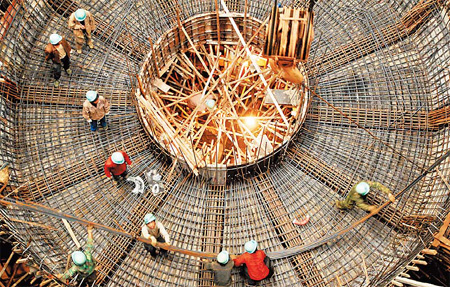
Workers are busy building the new Dongbei Special Steel Group plant in Dalian, Liaoning province. China is experiencing a construction boom thanks to a 4-trillion-yuan stimulus package initiated by the government. [China Daily/Liu Debin]
|
|
The government should improve the portfolio of the stimulus package to avoid over-construction, top legislative officials said yesterday. The comments come one year after the government made a swift response to combat the worst global financial crisis since the 1930s.
Fully approving the package's essential role in reviving the economy and improving people's livelihoods, officials at the 11th session of the Standing Committee of the 11th National People's Congress (NPC) said the package was "correct, timely and effective".
So far the government has spent 1.18 trillion yuan ($148 billion) in public projects since the fourth quarter last year. Some 252.2 billion yuan was spent in agriculture, 213.4 billion yuan in large-scale infrastructure, and 92.6 billion yuan in education and health.
By the end of August, more than 1.26 million flats of low-rent housing were under construction. Nearly 4 million sq m of new school buildings have been completed in the middle and western rural areas.
"Some regions made plans for the financial aid from central government and caused waste," said Shi Xiushi, a member of the finance and economy committee of the NPC.
"Some technology innovation projects are not well prepared or do not fit their area's industrial structures," Shi added.
The research teams also doubted the practicality of building roads that link villages with only a few farmers in some rural areas.
On the other hand, a drastic decline in local financing has also challenged some public projects requiring a large proportion of local investment.
The top legislature said the package should be optimized in order to prevent repeated construction, and the local governments should be more risk-conscious about bank loans.
"More research is necessary before a project starts," said Jia Kang, director of the Research Institute for Fiscal Science at the Ministry of Finance. "Related departments should be involved in making plans, or else we won't avoid wastes."
Louis Kuijs, a World Bank economist, praised China's stimulus package's success in fueling a boom in infrastructure investment and keeping consumer confidence up.
But he also pointed out potential risks.
"Some of the increase in bank lending has flown to the property and stock markets. Particularly in the third quarter, on the back of a recovery in the real estate market, an increasing share of the new lending went to mortgages."
Kuijs said he believes it's too early to say that China is facing asset price bubbles.
"But with today's loose monetary conditions, the risks of unwarranted asset price rises and misallocation of credit increases over time."
Besides the huge investment in infrastructure, "more is needed to boost the role of consumption in China's economy on a sustained basis", Kuijs told China Daily.